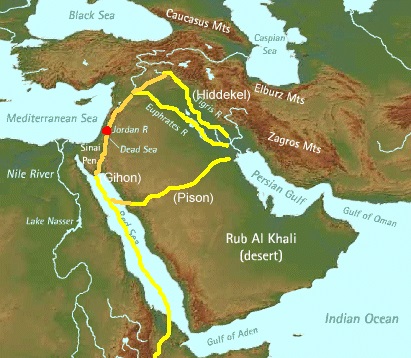The question of which river flowed out of the Garden of Eden has captivated theologians, historians, and curious minds for centuries. The Book of Genesis describes a river originating in Eden that then divided into four headwaters: Pishon, Gihon, Tigris (Hiddekel), and Euphrates (Perath). Identifying these rivers and pinpointing their exact locations has proven to be a complex and often debated undertaking. The geographical descriptions provided in the Bible, coupled with the passage of time and potential geological shifts, make definitively answering the question of which river flowed out of the Garden of Eden a significant challenge.
The Four Rivers: A Closer Look
The biblical text offers descriptions of each of the four rivers, though the details are often sparse and open to interpretation. Let’s examine each one individually:
- Pishon: Described as encircling the entire land of Havilah, known for its gold, bdellium, and onyx. Its modern-day equivalent remains largely unidentified, sparking numerous theories.
- Gihon: Said to encircle the land of Cush. Like the Pishon, its modern identification is uncertain, with some suggesting it might be related to the Nile River.
- Tigris (Hiddekel): This river is explicitly identified and corresponds to the modern-day Tigris River in the Middle East.
- Euphrates (Perath): Also explicitly identified, this river corresponds to the modern-day Euphrates River, also located in the Middle East.
The Tigris and Euphrates: Anchors in the Mystery
The identification of the Tigris and Euphrates rivers provides a crucial anchor point in the search for the Garden of Eden. These two rivers still exist today, flowing through modern-day Iraq, Syria, and Turkey. This suggests that the Garden of Eden, if it existed in a physical location, was likely situated somewhere in the Middle East. However, the exact location and the identities of the Pishon and Gihon remain subjects of ongoing debate.
Possible Interpretations and Theories
Numerous theories attempt to reconcile the biblical descriptions with known geography. Some suggest that the Pishon and Gihon were rivers that have since dried up or changed course due to geological events. Others propose that the biblical account is not meant to be taken literally, but rather as a symbolic representation of a spiritual or mythical realm. Still others suggest that the names of the rivers were applied to different geographical features over time.
The search for the Garden of Eden and its rivers continues to fascinate and inspire. While definitive answers may remain elusive, the quest itself offers valuable insights into history, geography, and the enduring power of biblical narratives.
FAQ: Rivers of Eden
- Q: Are the Tigris and Euphrates rivers mentioned in the Bible the same as the ones we know today?
- A: Yes, the Tigris and Euphrates rivers mentioned in Genesis are generally accepted to be the same rivers that flow through the Middle East today.
- Q: What about the Pishon and Gihon rivers?
- A: The identities of the Pishon and Gihon rivers are uncertain and subject to much debate. There is no consensus among scholars.
- Q: Is it possible to find the Garden of Eden today?
- A: The existence and location of the Garden of Eden are matters of faith and interpretation. There is no definitive scientific evidence to support its existence as a physical place.
Ultimately, the question of which river flowed out of the Garden of Eden is one that may never be fully answered. The mystery surrounding the Garden and its rivers continues to fuel speculation and inspire exploration, both geographical and theological.
The enduring allure of the Garden of Eden lies not just in its potential geographical location, but also in its symbolic representation of paradise, innocence, and the origins of humanity. The rivers, therefore, become more than just waterways; they represent the life-giving force that flowed from this idyllic source, nourishing the world and shaping its destiny. Understanding the context of the ancient world, its cosmology, and its understanding of geography is crucial when attempting to decipher the meaning behind the biblical narrative.
The Impact on Culture and Theology
The rivers of Eden have had a profound impact on culture and theology throughout history. They have been depicted in countless works of art, literature, and music, often serving as symbols of purity, abundance, and the connection between humanity and the divine. In theological discourse, the rivers are often interpreted as representing the four cardinal virtues or the four Gospels, further enriching their symbolic significance.
The Search for Eden: A Modern Perspective
Even in the modern era, the search for the Garden of Eden continues to captivate the imagination. Satellite imagery, archaeological discoveries, and linguistic analysis are all being employed in an attempt to shed new light on the mystery. While a definitive answer may remain elusive, the pursuit of knowledge and understanding continues to drive the quest. The question of which river flowed out of the Garden of Eden remains a fascinating puzzle.
The enduring mystery of the Garden of Eden and its rivers serves as a reminder of the power of myth and the enduring human desire to understand our origins. Whether viewed as a literal historical account or a symbolic representation of spiritual truths, the story of Eden continues to resonate with people around the world. The first sentence of this final paragraph emphasizes the enduring fascination with the question of which river flowed out of the Garden of Eden.

